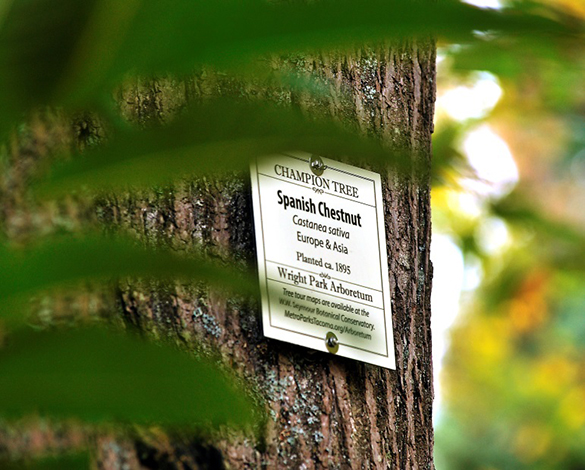Metro Parks Tacoma officials announced the completion of a sign installation project that aims to share information about the histories of more than 400 trees in Wright Park.
“Just by walking around, you will get a sense of the arboretum’s diversity,” said Metro Parks Tacoma Urban Forester Mark McDonough, who catalogued each of the trees in a descriptive database before the signs were hung on the trees. “I would encourage spending an hour or two walking around, reading labels, and stepping back to view trees as a whole. It’s enjoyable for any park user.”
Each of about 450 trees bears a label that identifies it by its scientific and common names, its geographic origin, and the year it was planted in the park. Most of the signs are attached about 10 feet above ground level. Many hang facing park paths, making them more visible to walkers and runners. Light-colored signs indicate champion trees, meaning those recognized for dimensions outstanding for the species, or are historically significant to the park. Other signs are brown and blend unobtrusively into their surroundings. For example, what is probably the park’s most famous tree, nicknamed the Roosevelt oak — standing close to the W. W. Seymour Conservatory, located at 316 S. G St. — is labeled “1903.” The tree was planted in honor of President Theodore “Teddy” Roosevelt, who visited Tacoma that year.
Metro Parks Tacoma officials are developing a new brochure that will highlight many of the champion trees, lay out a walking tour, and include a map. The brochures probably will be printed early this year, and will be available in the W. W. Seymour Conservatory and online at metroparkstacoma.org/arboretum.
But you don’t have to wait for the brochures to check out the new signs and appreciate the arboretum’s long history. McDonough suggests starting at the Conservatory and walking along South G. Street. “Take a look at the red oaks,” added McDonough. “The size of them is astounding. And not just the Teddy Roosevelt.” His other favorites include the American beeches, found throughout the park; the purple beeches, along Sixth Avenue, east of the park’s bowling green; and the rock elm, also near the bowling green, with its deeply furrowed bark and its narrow, cylindrical shape.
Wright Park’s history dates back to 1886, when the Tacoma Land Company donated 27 acres of vacant land for a public park. At the time, the site was barren, muddy, and likely devoid of native trees, which had been logged off for commercial sale, according to Metro Parks Tacoma officials. But conditions attached to the land donation required that at least 300 ornamental shade trees be planted on the grounds within four years. Soon after that, experts brought in additional trees from throughout the United States and parts of Europe. Today, the Wright Park arboretum boasts 138 species of more than 600 trees that are nurtured for educational display and public appreciation.
More information about Wright Park is available online at metroparkstacoma.org/wright-park/.







